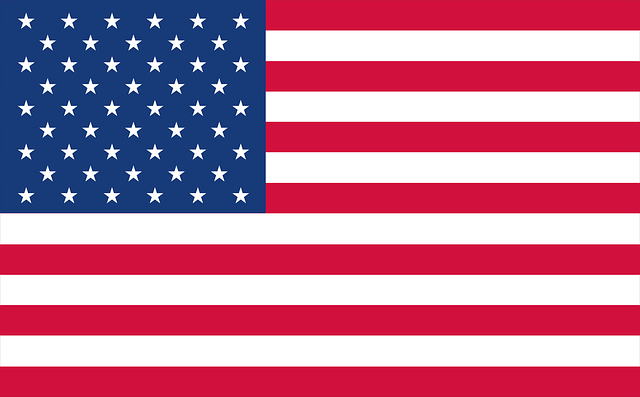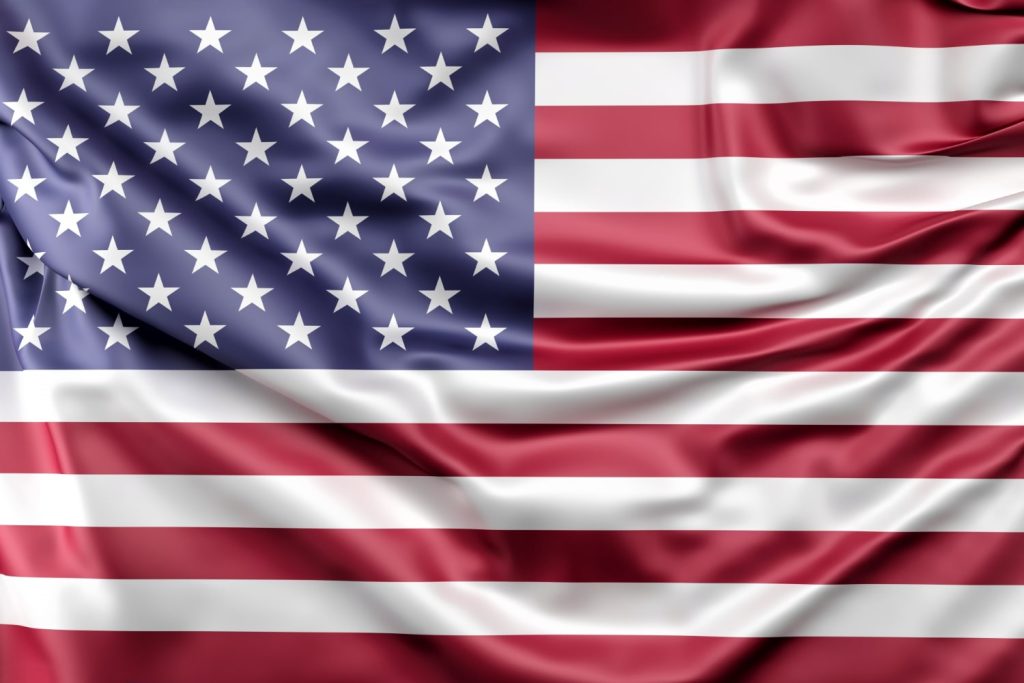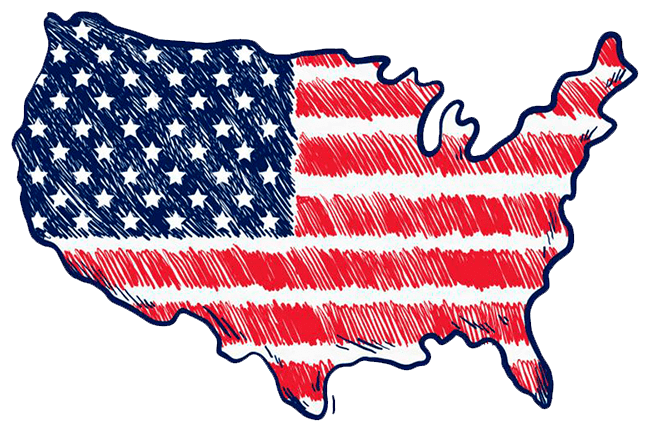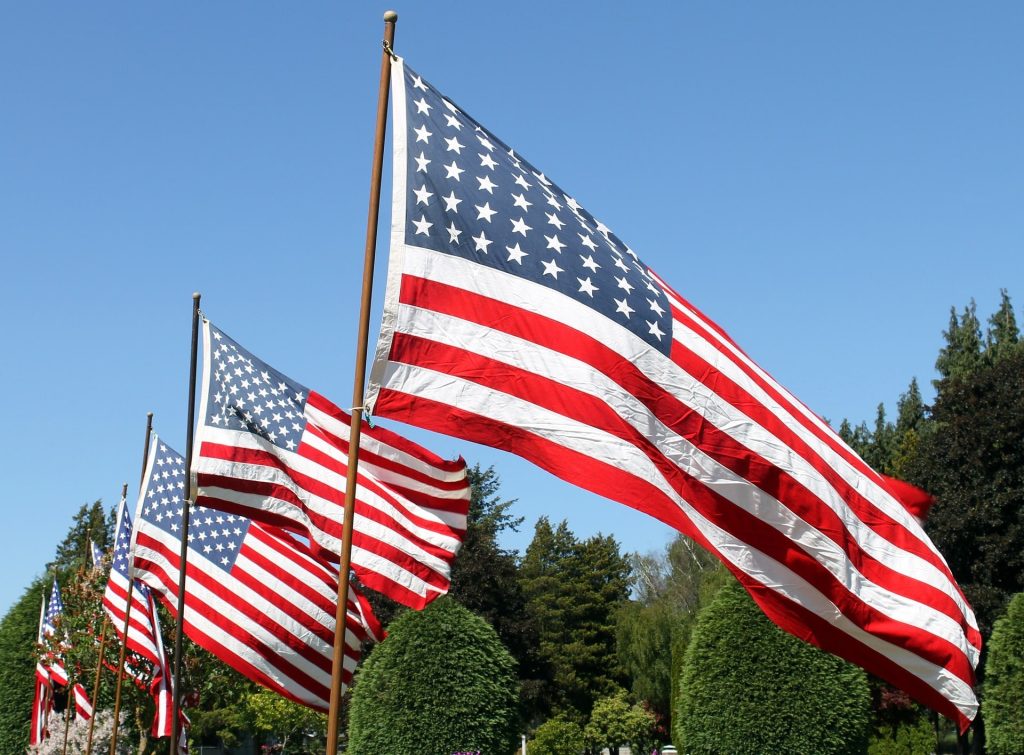Flag of the United States of America (USA)

American flag (USA)
- Official approval of the flag: 1960 year
- Flag emoji: 🇺🇸
- Period: Modern flags
- Type of flag: Flags of countries • Flags of continental countries
- Belonging to the continent: America • North America
- Colors on the flag: white • blue • red
- Emblem on the flag: зірки
The United States of America (USA) is located in North America, bordering Canada and Mexico, and has access to the Atlantic and Pacific Oceans. The capital is Washington, DC. The country’s area is about 9.63 million km², with a population of over 331 million people. The United States declared independence from Great Britain on July 4, 1776. There is no official language at the federal level, but English is the de facto main language. The ethnic composition is very diverse, with the majority being of European, African American and Latin American descent; religion is predominantly Christian.

The flag of the United States of America, also known as the Stars and Stripes or Old Glory, is one of the most famous national symbols in the world. Its design of 13 stripes and 50 stars embodies the history, unity and development of the American nation.

History of the US flag
The origin of the flag
- 1777: On June 14, the Continental Congress adopted the first official version of the US flag. It had 13 red and white stripes and 13 white stars on a blue field, symbolizing the first 13 states.
- Design by Betsy Ross: According to a popular legend, the first flag was sewn by seamstress Betsy Ross, but there is no documentary evidence of this.
Stages of change
- 1795-1818: The number of stars and stripes changed as new states were added.
- 1818: Congress established that the number of stripes would remain at 13 and the number of stars would increase with each new state.
- 1960: The current version with 50 stars was adopted after Hawaii became a part of the United States.

Colors of the US flag
The meaning of the American flag
The US flag has a deep symbolic meaning:
- The 13 stripes (7 red and 6 white) symbolize the 13 colonies that declared independence from Great Britain in 1776.
- The50 stars represent the 50 states that make up the United States.
- The blue field (the Union) represents the unity of all the states.
Color meanings (as interpreted by the State Department):
- Red represents bravery and courage.
- White – purity and innocence.
- Blue – vigilance, endurance and justice.
Flag color codes
The official colors of the U.S. flag are defined for accurate reproduction:

- Old Glory Red:
- RGB: (179, 25, 66)
- HEX: #B31942
- Pantone: 193 C
- White:
- RGB: (255, 255, 255)
- HEX: #FFFFFF
- Pantone: White
- Old Glory Blue:
- RGB: (10, 49, 97)
- HEX: #0A3161
- Pantone: 281 C

Format and proportions
The flag of the United States has a clearly defined geometric format.
Flag proportions
- The official aspect ratio is 10:19 (height to length).
The arrangement of the elements
- Stripes: 13 horizontal stripes, starting from the top with red.
- Canton (blue field with stars):
- Located in the upper left corner.
- Contains 50 white five-pointed stars arranged in 9 rows (5 rows of 6 stars and 4 rows of 5 stars).

Flag raising ceremony
The raising of the U.S. flag is an official state ritual, accompanied by solemnity and precise protocol.
When the American flag is raised
- Every day: At military bases, government facilities, and many schools, the flag is raised every morning and lowered at sunset.
- Official days: The flag is flown with special ceremony on the following dates:
- July 4 – US Independence Day
- June 14 – Flag Day
- November 11 – Veterans Day
- Memorial Day – the flag is first raised, then lowered to half-staff by noon
How the US flag is raised
- Beginning: The flag is raised quickly and solemnly.
- Accompaniment: A rendition of the U.S. national anthem, The Star-Spangled Banner, is often used.
- Respect:
- Civilians place their right hand over their hearts.
- Military personnel salute.
- Lowering: On days of mourning, the flag may be flown at half mast with appropriate protocol.

Interesting facts about the US flag
- The largest flag: One of the largest flags in the United States flies in the state of North Carolina, with an area of over 1000 m².
- Moon flag: The US flag was planted on the moon during the Apollo 11 mission in 1969.
- Itis the oldest surviving flag: The original inspiration for the U.S. national anthem “The Star-Spangled Banner” is on display at the National Museum of American History.
- Each new star is a new state: The last time the number of stars was changed was in 1960, when Hawaii became the 50th state.
The US flag is not just a national symbol. It is the embodiment of American values, unity and freedom. Its daily raising is not just a formality, but an expression of national pride and respect for the country’s history.
